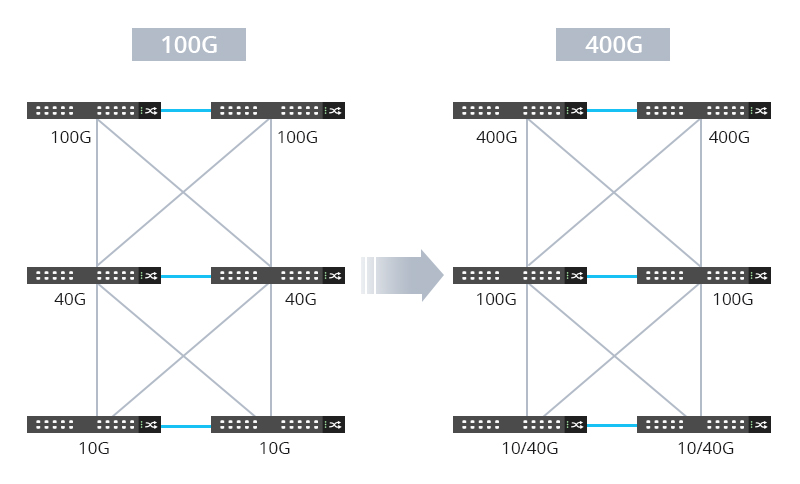ADOP 400G Product Family Introduction
High-Capacity 400G Data Center Trends
The market for 400G data center networking is skyrocketing and becoming increasingly competitive. Virtual data center builds, Internet of Things (IoT), and cloud computing are all fueling the unrelenting expansion of data center traffic and demand for high capacity 400G data center networking solutions.
As a promising and evolving technology, 400G Ethernet delivers great speeds, high-volume capacity, and simplified upgrades from 100GbE to 400GbE. This article elaborates on what cloud operators, service providers and enterprises alike need to consider before the upgrade and how ADOP 400G portfolio can help.
Update from 100G to 400G Network
Currently most data centers, metros, and long haul networks are using cost-effective 100G connectivity. To make the upgrade viable, there are a number of key considerations for network operators and enterprises that are planning to get their network to the next level.
Infrastructure Upgrade
Upgrading from a 100G network to a 400G one requires architecture transformation to support 400Gbps data transfer rate, which means you have to upgrade a range of products in your data center infrastructure.

400G switches are a must, and naturally you need 400G transceivers. QSFP+ and QSFP28 transceivers in a 100G network are not enough. As QSFP-DD form factor owns an overwhelming majority of 400G interface in the market, you now have to choose from a series of QSFP-DD transceivers. New types of transceivers also pin new demand on cable infrastructure.
So there are a couple of ways to enable the connection between 100G ports to 400G switches. For example, you can connect a 400G port to 4x 100G ports with one QSFP-DD transceiver and four QSFP28 transceivers. Or you can use 400G breakout DAC/AOC cables to make it work, which proves to be a cost-effective way in short-reach applications.
Backward Compatibility
Another consideration that needs to be taken into account is backward compatibility. QSFP-DD network element ports are backwards compatible to pluggable NRZ (non-return zero) QSFP transceivers, DACs and AOCs. The practical benefit of backwards compatibility is that you can connect a legacy NRZ 100G QSFP network element to a QSFP-DD switch with a legacy DAC or AOC. However, legacy QSFP28 and QSFP+ ports are not forwards compatible with QSFP-DD pluggables. Thus, before upgrading to 400G network with legacy devices, you should ensure switches, transceivers, and fiber optic cables etc are compatible in your infrastructure.
NRZ or PAM4 Modulation
Currently, there are two different signal modulation techniques: non-return to zero (NRZ), and pulse-amplitude modulation 4-level (PAM4), which is applied in both 100G and 400G networks. Theoretically, 16× 25G baud rate NRZ can be used for 400G Ethernet, such as 400G-SR16, but the link loss and size of the scheme can not meet the demands of a high-performance 400G network. Whereas PAM4 enables higher bit rates at half the baud rate, which means that data center operators can continue to use existing channels at potential 400G Ethernet data rates. As a result, PAM4 has overtaken NRZ as the preferred modulation method for optical signal transmission in 400G optical modules.
However, PAM4 and NRZ connections, as mutually exclusive modulation methodologies, are not interoperable. This means network operators need to factor in this aspect and map out a detailed plan to integrate legacy networks into 400G networks.
New Complexities
Apart from the aforementioned points above, 400G upgrades involve a series of other complexities. As 400G enables a four-fold increase in maximum data transfer speed over 100G, network operators have to plan for the required interfaces, link distances, new standard and practical considerations of the shift to new devices or technologies. Moreover, they will look for efficient and high-quality 400G solutions to avoid costly upgrades down the road.
Explore ADOP 400G Portfolio
To fulfill the unique customer 400G demands, ADOP offers a complete portfolio of 400G switches, optical transceivers, fiber optic cables and so on. ADOP 400G solutions will increase efficiencies throughout your network while keeping it secure, customizable, and low-cost, making them ideal for high-volume cloud providers, data centers, and enterprises grappling with unrelenting traffic growth. The following figure shows a high-density 400G solution with products in ADOP 400G portfolio.
Holistic 400G Architecture
ADOP 400G portfolio offers comprehensive and high-performing 400G products designed to improve customer experience and meet various customer demands. Whether you are looking for 400G switches, 400G transceiver modules, 400G DACs or AOCs, or 400G fiber optic cables, we have what you need. ADOP 400G portfolio provides the full range of capabilities and features essential to fulfilling the most important and highest priority requirements.
Maximum Flexibility
With ADOP 400G switch as a spine switch, ADOP 400G solutions support 100/400G spine interconnects. This 400G open network switch has 32 ports backward-compatible with SFP28, QSFP+, QSFP28, and QSFP56. Each QSFP-DD port can operate at 400, 200, 100, 40 native speeds and 200, 100, 50, 25 Gbps breakout, which ensures maximum flexibility in a 400G data center network.
Compatibility for 400G Fabric
ADOP 400G portfolio supports Open Network Install Environment (ONIE), which enables the installation of compatible Network Operating System software, including the open source options Open Network Linux, plus commercial NOS offerings. In other words, ONIE enables an open networking hardware ecosystem where end users have a choice among different network operating systems.
High-Quality Data Transmission
With complete QOS strategy and queue scheduling mechanism, ADOP 400G portfolio ensures the easing of congestion and high-quality data transmission. Based on network flow control functions such as PFC/ECN, it can build an end-to-end, lossless, low-latency forwarding RDMA basic bearer network, which is necessary for modern data center applications.
ADOP 400G Featured Products
ADOP is well prepared to address the need for smart, cost-efficient 400G data center network solutions. Here is a list of 400G products ADOP offers in a 400G portfolio. For more info, please check ADOP 400G Product Family Introduction.
| ADOP 400G Featured Products | Specifications & Advantages |
|---|---|
| 400G Data Center Spine Switch |
|
| 400G QSFP-DD Transceiver |
|
| 400G QSFP-DD AOC |
|
| 400G QSFP-DD DAC |
|
| 400G Breakout Cable |
|
| 400G MDC cable |
|
Today’s network infrastructures require built-in scalability, flexibility, simplicity, and security. In reliable and cost-efficient ways, ADOP strives to support burgeoning bandwidth demands now and in the future.
With higher throughput, savings on power, cost and space, and more interconnect options, ADOP 400G solutions are designed to help cloud operators, service providers and enterprises achieve these goals as they continue to innovate in the cloud era.






